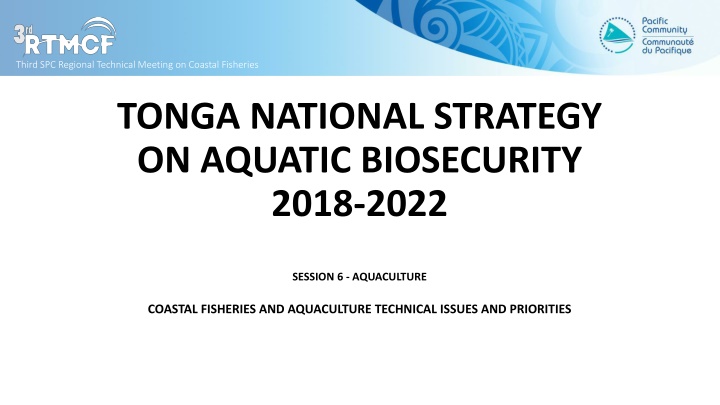
Tonga Aquatic Biosecurity Strategy for Sustainable Aquaculture Development
The Tonga National Strategy on Aquatic Biosecurity 2018-2022 focuses on enhancing aquaculture practices in Tonga while ensuring biosecurity measures to prevent the spread of aquatic pathogens and invasive species. The strategy outlines components such as Mabe pearl farming, seaweed farming, and collaborations with coastal communities for sustainable growth. It highlights the need for compliance with international standards, market opportunities, and environmental preservation. Future trends in the aquaculture sector include the introduction of new species like sea urchin and Nile tilapia.
Download Presentation

Please find below an Image/Link to download the presentation.
The content on the website is provided AS IS for your information and personal use only. It may not be sold, licensed, or shared on other websites without obtaining consent from the author. If you encounter any issues during the download, it is possible that the publisher has removed the file from their server.
You are allowed to download the files provided on this website for personal or commercial use, subject to the condition that they are used lawfully. All files are the property of their respective owners.
The content on the website is provided AS IS for your information and personal use only. It may not be sold, licensed, or shared on other websites without obtaining consent from the author.
E N D
Presentation Transcript
Third SPC Regional Technical Meeting on Coastal Fisheries TONGA NATIONAL STRATEGY ON AQUATIC BIOSECURITY 2018-2022 SESSION 6 - AQUACULTURE COASTAL FISHERIES AND AQUACULTURE TECHNICAL ISSUES AND PRIORITIES
OUTLINE 1. Aquaculture in Tonga 2. Technical justification 3. Guiding principles of the Strategy 4. Components of the Strategy 5. Implementation 6. Challenge & Limitation
AQUACULTURE SECTOR IN TONGA Mabe pearl farming Spats hatchery produced Grow-out small-scale coastal farmers Pteria penguin Handicraft and human consumption Giant clam farming Spats hatchery produced Grow-out various private farmers/exporters Tridacna spp. and Hippopus spp. Ornamental market
AQUACULTURE SECTOR IN TONGA Mozuku seaweed farming Seedlings are harvested from the wild Grow-out Private company in collaboration with coastal communities Chladosiphon okamuramus Export to Japan, USA and EU human consumption and pharmaceutical use Golden sandfish farming Juveniles hatchery produced Grow-out in sea ranching Holothuria lesoni Chinese/Tonga joint venture Processing in Tonga Export to China
AQUACULTURE SECTOR IN TONGA Future trends Sea urchin Anadara sp. (Ark Shell) Nile tilapia (exotic species) other tilapia species already present in Tongan waters Red seaweed Kappaphycus alvarezii (exotic species) already present Rabbifish (local species) Prawns
TECHNICAL JUSTIFICATION Why do we need a Strategy on Aquatic Biosecurity? Reduce the risk of introduction and spread of aquatic pathogens Reduce the risk of introduction and spread of invasive aquatic species Assure compliance with international standards for aquaculture products Ornamental products giant clams, corals, marine finfish Edible products sandfish, seaweeds Increase market opportunities Engage in fair trading practises Preserve aquatic environment and biodiversity
GUIDING PRINCIPLES OF THE STRATEGY Vision The Government of Tonga and the National aquaculture sector working together to minimize the introduction and spread of biological risks (e.g., pathogens, invasive species) in aquatic environments. Mission The mission of this strategy is build national capacities at all levels on aquatic biosecurity, in order to improve aquatic species health management and meet international trade standards, as a way to ensure food safety, food security and income generation.
GUIDING PRINCIPLES OF THE STRATEGY Objectives 1. Improve the sustainability and productivity of the aquaculture sector in Tonga. 2. Maintain the traditional and cultural uses of aquatic resources in the country. 3. Facilitate the development of potentially new aquaculture production systems. 4. Maintain and strengthen the capacity of the aquaculture sector to engage in fair trading practices. 5. Protect the health and biodiversity of aquatic organisms and aquatic ecosystems. 6. Improve knowledge on current aquatic species health status.
GUIDING PRINCIPLES OF THE STRATEGY Scope Aquatic species health management: including aquatic species diseases diagnosis, prevention, control, treatment, surveillance and national/international reporting, with special emphasis on farmed aquatic species. Aquatic species imports and exports: including the development and/or update of national standards for live aquatic species and their products imports and exports, with special emphasis on quarantine procedures/operations, certification schemes, permitting, border control, import risk analysis and environmental impact assessment.
COMPONENTS OF THE STRATEGY 1. Aquatic species health management - Improved health management: diagnosis, control, treatment and reporting of diseases in aquatic organisms. 2. Import and export standards - Transparent, inclusive and comprehensive import/export standards for aquatic organisms. 3. On-farm biosecurity - Improved aquatic biosecurity (hygiene) practises at farm level 4. Governance - Update/development and enforcement of specific regulatory framework on aquatic biosecurity 5. Emergency planning - Preparedness to aquatic animal diseases outbreaks
IMPLEMENTATION STRATEGIES Recruitment of a new aquatic biosecurity officer working in close collaboration with the aquaculture and compliance section, as well as with aquaculture farmers. Roles of the new biosecurity officer: 1. Assurance of on-farm biosecurity practises 2. Review and update of import/export standards for aquatic organisms 3. Review and update of introduction standards for exotic aquatic organisms 4. Development of better management strategies at farm level 5. Assessment of existing aquaculture facilities
CHALLENGES & LIMITATION 1. Financial Resources 1. Human capacities 1. Political will
